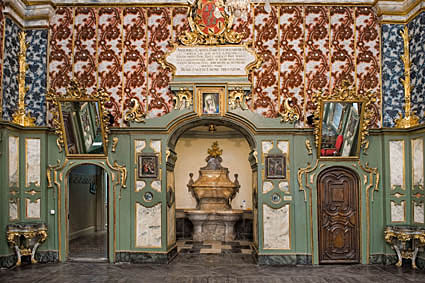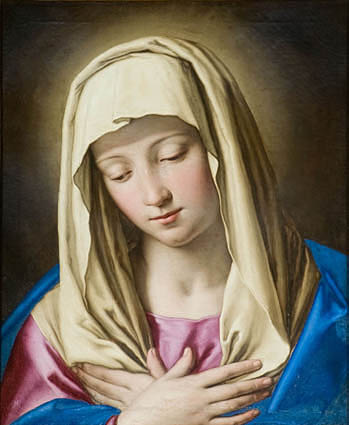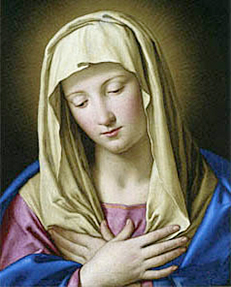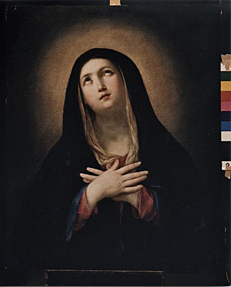The piece of the month of October 2009
A PRAYING VIRGIN BY SASSOFERRATO IN THE MAIN SACRISTY OF THE CATHEDRAL OF PAMPLONA
José Luis Requena Bravo de Laguna
Chair of Navarrese Heritage and Art
The main sacristy of the cathedral of Pamplona is one of the most unique artistic areas of the medieval temple, an elaborate and extravagant space decorated in the style of French rococo imported into Spain in the early eighteenth century. Consoles of polychrome and gilded wood, cornucopias in the shape of a kidney with a rockery coping and skirt and other furniture give the sacristy a singular aesthetic language more typical of a palatial dependency than of a sacred room. This paradox would not leave indifferent travelers and onlookers of the 19th century, among whom we have two valuable testimonies. The first is due to the academic and painter Pedro de Madrazo, who describes it in this way: There can be no greater contrast than that of its door with the cheerful, luminous, worldly, almost sybaritic interior of a sacristy disguised as a concert hall or aristocratic boudoir by the profane imagination of a decorator of the time of King Carlos III of Spain. The great French poet and novelist Victor Hugo is more succinct but no less graphic: Imagine an immense rococo hall, gilded, historiated, flowery, flirtatious, perfumed and enchanting? Dante is in the cloister; Madame Pompadour in the sacristy.

Sassoferrato, "Sacristía mayor", Pamplona Cathedral.
Indeed, the pompous and sybaritic appearance of the main sacristy is due to the generous patronage of Don Pedro Fermín de Jáuregui y Aldecoa, canon dignitary and archdeacon of the cathedral, and son of the Jaureguía de Ohárriz house, in Lekároz. This illustrious man from Baztan, brother of two other great makers of La Hora Navarra in the 18th century, Don Agustín de Jáuregui, viceroy of Lima, and Francisco Martín de Jáuregui, congregant of San Fermín de los Navarros, must have become familiar with the sumptuous rococo interiors during his long stays in the Villa y Corte. financial aid For the reform he had the help of the architect and decorator Silvestre de Soria, partner of the Italian Juan Antonio de Olivieri in the ornamental decoration of the Royal Palace, and the painter and gilder Pedro Antonio de Rada from Pamplona.
Precisely, this last one intervened in the pictorial decoration of the set by means of some monumental canvases, located in the half points of the cover, and dedicated to the cycle of the Life of the Virgin to whom the cathedral is consecrated: Birth, Flight to Egypt, Jesus between the doctors, Dormition and Assumption. On the head wall there is a sixth scene, the first sin of Adam and Eve, which in turn inaugurates a new cycle -located on a lower level- with the Passion topic : Arrest, Flagellation, Carrying the Cross and the Pietà. Completing the decoration are the paintings located on both sides of the lateral spaces: Annunciation, presentation of the Virgin in the Temple, Resurrection and Ascension, as well as a third group of small canvases and coppers that are scattered on the first level of the sacred precinct.
On the other hand, it is worth remembering that the origins of the main sacristy date back to the second half of the 16th century, during the episcopate of Don Diego Ramírez Sedeño de Fuenleal, when only the foundations were opened, leaving the project unfinished. Finally, it will be the new prelate Don Antonio de Zapata y Mendoza the patron who would culminate the construction of the sacristy in 1599, as we can read today in the Latin registration located on the wall of access to the entrance to the washbasin.

Sassoferrato, "Virgin praying", Main Sacristy, Pamplona Cathedral.
Well, located in a privileged place, just below the coat of arms of don Antonio Zapata, between the space that delimits the registration and the carpanel arch, presiding over the main sacristy is a delicate praying Virgin of great quality and refinement, which leads us to think that we are before an autograph work of the Italian painter Giovanni Battista Salvi, "Il Sassoferrato" (1609-1685). The canvas, measuring 46 x cm, represents the serene countenance of the Virgin Mary with her hands crossed over her torso, and with her gaze looking downwards at a vague point outside the painting, in a gesture of sincere humility. The brushstroke is precise and modeling, the artist delighting in the realization of the folds of the canvases. His coloring is rich and vibrant, predominating the white, pinkish tones and the intense blue of the mantle. The directed illumination enhances the splendorous head of Mary on a neutral background of grayish tones. It is a subject conceived by Sassoferrato himself, of which we know of at least five copies, the cathedral canvas and two others from private Italian collections being of the highest quality. The model probably derives from a prototype of the Bolognese seicento of which we know a very close version by Guido Reni in a private Roman collection. At present, written sources have not yet revealed the immediate provenance of this beautiful work, and under what circumstances it arrived at the Pamplona cathedral.
These devotional paintings that were so popular in the second half of the 17th century respond to a new aesthetic sensibility in accordance with the Tridentine prescriptions regarding the representation of sacred images. The pictorial world devised by Sassoferrato takes to the extreme that severe classicism defended by the painter Andrea Sacchi and his followers, by reinterpreting the models of the brilliant Raphael of Sanzio but devoid of all decorative and profane artifice that could hinder that direct, static, quasi-mystical vision, which brings him closer to the Byzantine tradition of the icon.


Sassoferrato, "Madonna praying", private collection, Italy. Guido Reni, "Madonna in contemplation", private collection, Rome.
Giovanni Battista Salvi, better known as "Il Sassoferrato", a nickname alluding to the small town in the Marche region where he was born, began his artistic career at training under the guidance of his father Tarquinio Salvi, a modest late-Mannerist painter of whom a cycle of mediocre quality dedicated to St. Francis of Assisi is preserved in the church of Santa Maria della Pace in Sassoferrato. In 1629, when Sassoferrato was twenty years old, we find him in the Roman Piazza dei Signori sharing a room with the great Roman-Bolognese painter Domenico Zampieri, "Il Domenichino" (1581-1641), who was to be the young artist's teacher. It was in these early years that he became familiar with the classicist, elegant and serene language inherited from the second generation of Bolognese painters - Il Guercino, Domenichino, Reni - as opposed to the triumphant style of the Cortoni imposed by Pietro da Cortona from Arezzo. In 1630 the Benedictine monks of the monastery of San Pietro in Perugia asked him to paint a copy of the venerated image of the Madonna del Giglio by Giovanni di Pietro, "Lo Spagna" (1450-1528) to decorate the cell of the abbot Leone Pavoni. Also for the same monastery he painted ten monumental canvases of Benedictine saints inspired by models of Sanzio's Perugino and Raphael. Other sporadic commissions led him to visit cities such as Florence and Bologna, settling definitively in the Eternal City around 1641.
Sassoferrato combined in Rome the internship of the religious devotional painting, specialization program where he reaped great successes, with that of the official document of portraitist of high ecclesiastical dignitaries, eloquent testimony of which are the Portrait of Cardinal Rapaccioli (Ringling Museum, Sarasota), a Portrait of Monsignor Ottaviano Prati (Galleria Nazionale d'Arte Antica, Rome) and the Portrait of Cardinal Pietro Ottoboni (Museo Civico, Padua). His most important work of those years is The Madonna of the Rosary (Church of Santa Sabina all'Aventino, Rome), a monumental altar canvas commissioned by Princess Pamphili di Rossano that will bring him the longed-for commissions. Around 1648 he married Angela Miccini from Bologna, and the following year his first-born son Francesco was born, establishing his new home in the neighborhood of San Salvatore ai Monti.
Probably, the lack of living space to accommodate his numerous offspring motivated a third move that ended with the purchase of a large house in via Baccina around 1657. It was here that he must have set up his large workshop years later, made up of young apprentices who were able to become accustomed to a "recipe" and somewhat artisanal way of the "Sassoferrato methodus" thanks to the repeated, almost indiscriminate use of his models of Madonnas, which brought him so many benefits. In 1685 Cardinal Flavio Chigi gave Cosimo III de Medici, Duke of Tuscany, the only known Sassoferrato Self-Portrait to decorate the brand new gallery of self-portraits of painters of the Corridoio Vasariano in the Ufizzi in Florence. On August 8, 1685 the painter died at the age of seventy-six, having made a will in favor of his six children.
bibliography
ALFONSI, G., Giovanni Battista Salvi detto Il Sassoferrato. La Madonna della Rosa, Vicenza, 2003.
GARCÍA GAINZA, C., "La sacristía mayor de la catedral de Pamplona: mecenas y artistas", Príncipe de Viana, no. 217, 1999, pp. 383-397.
MACÉ DE LÉPINAY, F., Giovanni Battista Salvi "Il Sassoferrato", Catalog of the exhibition, Milan, 1990.
PEPPER, S., Guido Reni. A complete catalogue of his works with an introductory text, New York, University Press, cat. no. 226.
PULINI, M., Il Sassoferrato, un prerafaellita tra i puristi del Seicento, Catalog de la exhibition, Cesena, 2009.
